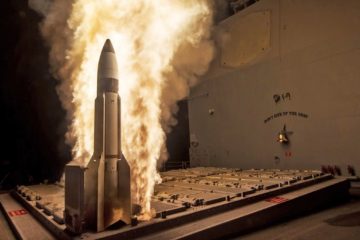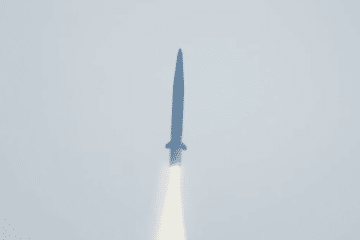On September 1st, South Korea’s ADD posted an RFP for the prototype of its “High-performance Large Underwater Launch System.” The RFP outlines plans to develop and deploy the prototype of the new VLS by 2027. The latest 3000-ton KSS-III Batch-I submarine (Dosan Ahn Chang-ho class), which currently has six VLS cells capable of firing Hyunmoo-IV-4 SLBMs and has already successfully completed two test fires, could potentially be retrofitted to accommodate this system once developed. Additionally, the follow-on class known as KSS-III Batch-II, currently being constructed by Hanwha Ocean and featuring ten VLS cells, could also be a recipient of this new system due to its larger size and enhanced capabilities.
In the disclosed RFP, ADD did not specify the target performance of the prototype. However, given that the missile ejection weight is noted as “00,000kg”, it is reasonable to anticipate that the weight of the missile loaded on this new system will be at least 10 tons. The missile ejection weight of the recently tested Hyunmoo-IV-4, loaded on the KSS-III Batch-I, is known to be around 5.4 tons with a 1-ton warhead. Given that the new missile ejection weight exceeds 10 tons, there is strong speculation that it could be an SLBM version of the Hyunmoo-V ballistic missile, which is known to have the heaviest conventional warhead and is larger than the Hyunmoo-IV-4. The Hyunmoo-V has concluded its development phase with test launches earlier this year and is awaiting mass production at the end of this year.
Additionally, the defined launch depth is noted as “000m”, “opening/closing time of the hatch to be 00 seconds at underwater 000m depth condition” and “water pressure withstand 00bar on the outer hatch”. This could indicates that the new system is expected to launch the missile from the deep sea. It has to be noted however that most submarines typically launch their missiles (anti-ship, land attack or SLBM) at or near the periscope depth. Launching a SLBM from a depth of 100 meters is technically possible if the missile is encapsulated (to protect it from water pressure), but such a requirement complicates things greatly…
According to the RFP, the primary task for the defense companies participating in the program is to develop the main equipment, which includes a launch tube, launch control device, canister (cylindrical tube), and mixed gas generator. The planned deadline for development is June 2027, with the manufacture of the prototype starting in December of this year. Land ejection is planned for July to September 2025, and underwater ejection tests are scheduled from November 2025 to March 2026.
The concept image of the launch platform and system, shared by ADD, depicts a round warhead, which is typically associated with Multiple Independently targetable Reentry Vehicles (MIRVs) that can deliver multiple warheads through a single ballistic missile. Since this is a mock rendering intended to simulate the mounted armament, determining the missile’s function or objective is challenging. Nevertheless, the development of a new, powerful SLBM and sophisticated launch system for the ROK Navy’s latest over-3000-ton KSS-III vessels sends a message that the Republic of Korea is engaged in the SLBM arms race to secure peace and balance in the region.
About KSS-III SLBM submarines
KSS-III Batch-I

Displacement: 3,358t (surfaced), 3,705t (submerged)
Length: 83.5m
Beam: 9.6m
Draught: 7.6m
Weapons: 6 x 533mm ATP torpedo tubes Babcock International WHLS (K761 Tiger Shark, C-Star-III), Submarine Launched Mobile Mine (SLMM), 6 x VLS (Hyunmoo-IV-4)
Propulsion System: Diesel-Electric AIP, 3 x Rolls-Royce MTU 16V396 Diesel Engine, 4 x Bumhan PH1 Fuel Cell
Battery: lead–acid battery
Speed: 20 knots (submerged)
Range: 18,520km (surfaced)
In an interview with The Korea Economic Daily (Hankyung), Choi Il, the head of the Submarine Research Institute, explained, “We believe that high-weight ballistic missiles of the Hyunmoo-5 type can also be mounted on the Dosan Ahn Chang-ho class submarine with modifications, such as reducing the number of launch tubes.” If the development of the new VLS is completed on schedule, the KSS-III Batch-I will have the opportunity to accommodate this new enhanced weapon system in its 6th to 7th year after commissioning.
KSS-III Batch-II

Displacement: 3,600t (surfaced), 4,000t (submerged)
Length: 89.4m
Beam: 9.7m
Draught: 7.6m
Weapons: 6 x 533mm ATP torpedo tubes Babcock International WHLS (K761 Tiger Shark, C-Star-III), Submarine Launched Mobile Mine (SLMM), 10 x VLS (Hyunmoo-IV-4)
Propulsion System: Diesel-Electric AIP,3 x Rolls-Royce MTU 12V 4000 U83 Diesel Engine, 4 x Bumhan PH1 Fuel Cell
Battery: lithium-ion battery
Speed: 20 knots (submerged)
Range: 18,500km (surfaced)
The KSS-III Batch-II, currently being constructed by Hanwha Ocean, is an enhanced version of the KSS-III Batch-I, with an 80% localization rate. Some of the primary differences from the KSS-III Batch-I include the adoption of a lithium-ion battery system (for increased submersion time), increased size and displacement, enhanced detection capability through a horseshoe-shaped sonar array and additional VLS cells. Moreover, the KSS-III Batch-II will operate with the Anti-Submarine Water Unmanned Underwater Vehicle (ASWUUV), developed by ADD and Hanwha. The ASWUUV is an XLUUV which will carry out enemy submarine tracking missions and conduct surveillance and reconnaissance missions in friendly waters. The first ship of the KSS-III Batch-II is expected to be launched in April 2025.






